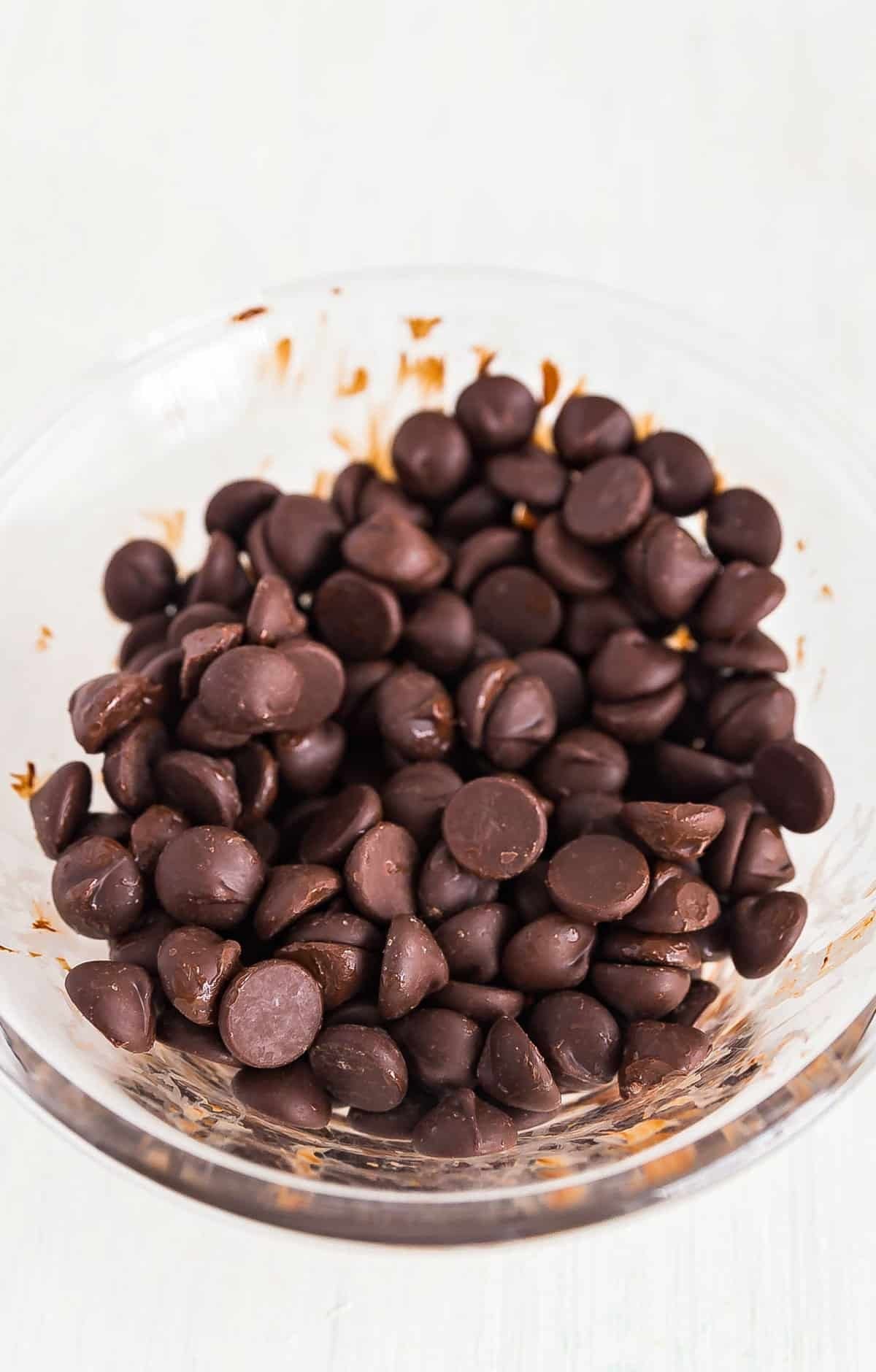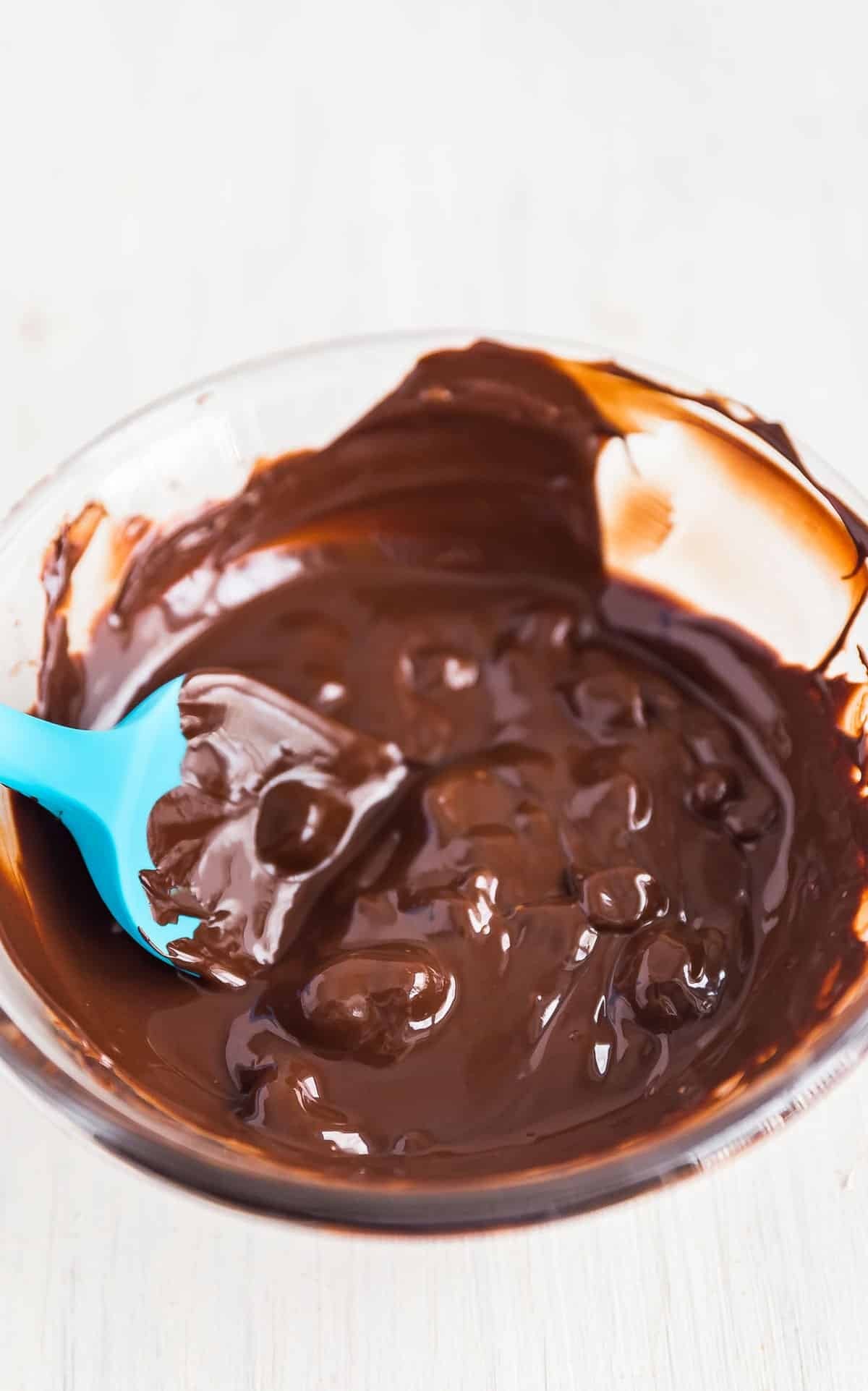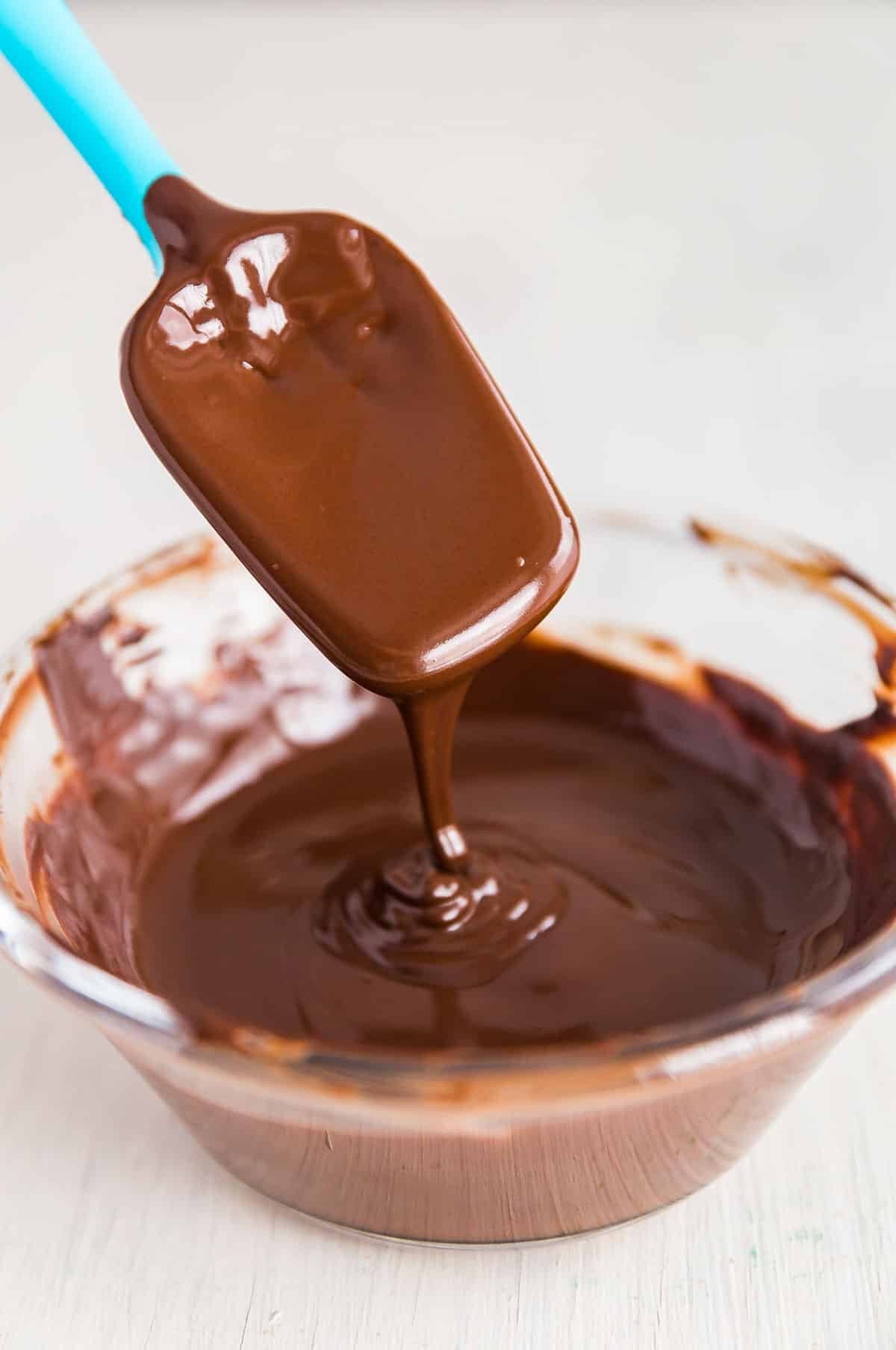Melting chocolate chips doesn’t have to be a daunting task; you can achieve perfectly smooth, melted chocolate using the microwave. At HOW.EDU.VN, we understand the nuances of culinary techniques and offer expert guidance to ensure your chocolate melts flawlessly every time, enhancing your desserts and treats with ease. Get ready to discover tips for working with chocolate melts, candy melts, and melting chocolate chips for dipping.
1. Why Should You Melt Chocolate Chips in the Microwave?
Melting chocolate chips in the microwave is a quick, efficient method that avoids the complexities of a double boiler. This approach is especially useful for those who value simplicity and speed in the kitchen. Unlike more traditional methods, microwaving chocolate chips minimizes setup and cleanup time while still delivering excellent results.
Here’s why you should consider melting chocolate chips in the microwave:
- Speed: The entire process takes just a few minutes.
- Convenience: No special equipment is needed.
- Ease of Use: It’s straightforward and easy to manage.
- Consistent Results: When done correctly, you achieve evenly melted chocolate every time.
- Versatility: Suitable for various types of chocolate chips and even chocolate chunks.
2. What Equipment and Ingredients Are Needed?
To melt chocolate chips effectively in the microwave, you’ll need minimal equipment and just one essential ingredient. Here’s what to gather before you start:
- Chocolate Chips: Select your preferred type of chocolate chips—semi-sweet, dark, milk, or white chocolate chips work well.
- Microwave-Safe Bowl: Ensure the bowl is microwave-safe to prevent any damage or chemical leaching during heating. A larger bowl can help prevent spills when stirring.
- Silicone Spatula: A spatula is ideal for stirring because it can scrape the sides of the bowl, ensuring all chocolate melts evenly.
3. How to Melt Chocolate Chips in the Microwave: A Step-by-Step Guide
Follow these detailed steps to ensure your chocolate chips melt smoothly in the microwave, avoiding common pitfalls such as burning or seizing.
Step 1: Prepare the Chocolate Chips
Pour the chocolate chips into your microwave-safe bowl, spreading them in an even layer. This helps them melt more uniformly.
Step 2: Initial Microwave Interval
Microwave the chocolate chips for 30 seconds on high power. This initial burst of heat starts the melting process.
Step 3: Stir Thoroughly
Remove the bowl from the microwave and stir the chocolate chips gently with your silicone spatula. Even if they don’t appear melted, stirring helps distribute the heat and prevent burning.
Step 4: Subsequent Microwave Intervals
Return the bowl to the microwave for another 30 seconds. After this interval, the chips should be visibly softer. Stir again, paying attention to the bottom and sides of the bowl.
Step 5: Final Melting Stage
Continue microwaving in 10-second intervals, stirring well after each. This prevents overheating and ensures a smooth, even melt. The chocolate should gradually become glossy and fluid.
Step 6: Check for Complete Melting
Once the chocolate is mostly melted but still has a few unmelted pieces, remove it from the microwave. The residual heat will melt the remaining bits as you stir, preventing any risk of burning.
Step 7: Stir Until Smooth
Stir the chocolate continuously until it is completely smooth and free of lumps. If it’s still not fully melted, microwave in an additional 5-second burst, stirring until perfect.
4. What Are the Key Considerations for Different Types of Chocolate?
Different types of chocolate have varying melting points due to their fat and sugar content. Understanding these differences can help you adjust your microwaving technique for optimal results.
| Chocolate Type | Fat Content | Sugar Content | Microwaving Tips |
|---|---|---|---|
| Semi-Sweet | Moderate | Moderate | Generally melts well; stir frequently to avoid burning. |
| Dark Chocolate | High | Low | Can seize more easily due to lower sugar; monitor closely and stir often. |
| Milk Chocolate | Moderate | High | Melts quickly due to high sugar content; use shorter intervals and stir continuously. |
| White Chocolate | High | High | Burns easily because of high sugar content; microwave in very short intervals (5-10 seconds) and stir constantly. |
| Chocolate Chunks | Varies | Varies | May take slightly longer to melt than chips; ensure even distribution in the bowl. |



5. What Common Mistakes Should You Avoid When Melting Chocolate Chips?
Melting chocolate chips can be tricky, and several common mistakes can lead to less-than-perfect results. Here’s what to avoid:
- Overheating: This is the most common mistake. Overheating can cause the chocolate to burn or seize, resulting in a grainy, unusable mass. Always use short microwave intervals and stir frequently.
- Moisture Contamination: Even a tiny amount of water can cause chocolate to seize. Ensure your bowl and spatula are completely dry before starting.
- Uneven Heating: Microwaves can heat unevenly. Make sure to spread the chocolate chips in an even layer and stir thoroughly between intervals to distribute the heat.
- Using the Wrong Type of Bowl: Always use a microwave-safe bowl. Some plastics can melt or leach chemicals into the chocolate, and metal bowls can cause sparks.
- Ignoring Residual Heat: Remove the chocolate from the microwave when it’s almost fully melted, and stir until the remaining pieces melt from the residual heat. This helps prevent burning.
- Not Considering Chocolate Type: Different chocolates melt differently. Adjust your technique based on the type of chocolate you’re using, as outlined in the previous section.
6. How Can You Troubleshoot Seized Chocolate?
If your chocolate seizes (becomes thick, grainy, and hard to work with), don’t despair! Here are a few troubleshooting steps you can try:
- Add a Small Amount of Liquid: Sometimes, adding a teaspoon of hot water or milk can help loosen the chocolate. Add the liquid gradually, stirring vigorously until the chocolate smooths out. Be cautious not to add too much, or the chocolate may become too thin.
- Incorporate Fat: Adding a small amount of vegetable oil or melted shortening can also help to restore a smooth consistency. Stir in a teaspoon at a time until the chocolate becomes more pliable.
- Continue Stirring: Sometimes, seized chocolate simply needs more stirring. Continue to stir the chocolate vigorously for several minutes to see if it smooths out.
- Use it in Baked Goods: If the chocolate cannot be salvaged for dipping or coating, it can still be used in baked goods such as brownies or cookies, where the texture is less critical.
7. What Are the Different Applications for Melted Chocolate Chips?
Melted chocolate chips are incredibly versatile and can be used in a variety of culinary applications. Here are some popular uses:
- Dipping: Melted chocolate is perfect for dipping fruits (like strawberries, bananas, and pineapple), pretzels, marshmallows, and cookies.
- Coatings: Use melted chocolate to coat candies, truffles, and bars, providing a smooth, professional finish.
- Ganache: Combine melted chocolate with heavy cream to create a rich ganache, which can be used as a glaze for cakes, a filling for pastries, or a base for truffles.
- Drizzling: Drizzle melted chocolate over desserts like ice cream, cakes, and pastries for an elegant touch.
- Ingredient in Baked Goods: Incorporate melted chocolate into batters for brownies, cakes, and cookies to enhance the flavor and add moisture.
- Decorating: Use melted chocolate to create decorative elements for cakes and cupcakes, such as chocolate shavings, curls, or piped designs.
8. How Should You Store Melted Chocolate?
Melted chocolate is best used immediately, as it tends to harden as it cools. However, if you need to store it, here are some tips:
- Keep it Warm: To prevent the chocolate from hardening, keep it in a warm place, such as over a pot of simmering water (double boiler method) or in a warming oven.
- Use a Heat-Safe Bowl: Ensure the bowl you’re using is heat-safe to avoid any damage or melting.
- Add a Thin Layer of Oil: Coating the surface of the melted chocolate with a thin layer of vegetable oil can help prevent a skin from forming.
- Store in an Airtight Container: If you need to store the melted chocolate for longer, transfer it to an airtight container and refrigerate. When ready to use, gently reheat in the microwave, stirring frequently.
9. Expert Insights on Enhancing Your Chocolate Melting Technique
To elevate your chocolate melting skills, consider these expert tips and insights:
- Use High-Quality Chocolate: The better the quality of the chocolate chips, the better the melted chocolate will taste and behave. Opt for brands with a higher cocoa butter content for smoother results.
- Add Flavorings: Enhance the flavor of your melted chocolate by adding extracts (such as vanilla, almond, or peppermint), spices (like cinnamon or chili powder), or liqueurs (such as Grand Marnier or Frangelico).
- Control Humidity: Work in a cool, dry environment to prevent moisture from affecting the chocolate. High humidity can cause chocolate to seize more easily.
- Consider a Chocolate Melter: If you frequently work with melted chocolate, consider investing in a chocolate melter. These appliances maintain a consistent temperature, keeping the chocolate smooth and ready to use for extended periods.
- Experiment with Textures: Adjust the texture of your melted chocolate by adding ingredients such as chopped nuts, dried fruits, or toffee bits.
10. Why Choose HOW.EDU.VN for Expert Culinary Advice?
At HOW.EDU.VN, we are committed to providing expert guidance and resources to help you master culinary techniques, from melting chocolate to creating gourmet dishes. Our team of experienced professionals and culinary experts is dedicated to offering personalized support and tailored solutions to meet your specific needs.
How Can HOW.EDU.VN Help You?
- Connect with Culinary Experts: Our platform connects you with experienced chefs and culinary instructors who can provide personalized advice and guidance on melting chocolate and other culinary techniques.
- Personalized Consultation: Receive tailored advice to address your specific challenges and goals, whether you’re a home cook or a professional chef.
- Access to In-Depth Resources: Explore our library of articles, tutorials, and recipes to expand your culinary knowledge and skills.
Are you struggling with melting chocolate or other culinary challenges? Do you want expert advice to elevate your cooking skills and impress your friends and family? Contact us at HOW.EDU.VN today and let our team of experts guide you to culinary success.
Address: 456 Expertise Plaza, Consult City, CA 90210, United States
WhatsApp: +1 (310) 555-1212
Website: HOW.EDU.VN
FAQ About Melting Chocolate Chips
Is it better to melt chocolate chips on the stove or in the microwave?
Melting chocolate chips in the microwave offers greater control over heat levels, reducing the risk of burning, and eliminates the need for a double boiler, making it a convenient option. Melting on the stovetop can be tricky, especially for beginners, making the microwave a preferred choice for ease of use.
Do you add oil to chocolate chips when melting?
Adding a tablespoon of coconut oil can help the chocolate melt more smoothly and give it a glossy finish, particularly useful when making dips for fruits. However, adding oil is optional and primarily for aesthetic purposes.
How do you melt chocolate chips without clumping?
To prevent clumping, stir the chocolate chips between each microwave session to ensure even melting. Regular stirring helps distribute heat and prevents the chocolate from becoming uneven and clumpy.
What can I do if my chocolate develops a clay-like consistency?
If chocolate develops a clay-like consistency, it has likely seized. While it may not be ideal for melting, you can still blend it into batter for baking, such as in brownies or cookies, where the texture is less critical.
Why is it important to make sure my bowl and spatula are dry when melting chocolate?
Even a small amount of moisture can cause chocolate to seize and become unusable. Ensuring that your bowl and spatula are completely dry helps maintain the proper consistency of the melted chocolate.
How often should I stir the chocolate while melting it in the microwave?
Stir the chocolate after each microwave session, typically every 30 seconds initially, and then every 10 seconds as the chocolate begins to melt. Frequent stirring helps distribute heat evenly and prevents burning.
What temperature is best for melting chocolate chips?
When using a double boiler, maintain a low simmer to gently melt the chocolate without overheating. In the microwave, use short intervals at high power, stirring frequently, to prevent burning.
Can I melt different types of chocolate chips together?
Yes, you can melt different types of chocolate chips together, but be aware that they may have different melting points. Monitor the mixture closely and stir frequently to ensure even melting.
How long does it take to melt chocolate chips in the microwave?
Typically, it takes about 2-3 minutes to melt chocolate chips in the microwave, using 30-second intervals followed by 10-second intervals, with stirring in between each.
What are some common uses for melted chocolate chips?
Melted chocolate chips can be used for dipping fruits, pretzels, and marshmallows, as well as for coating candies, truffles, and creating ganache for cakes and pastries.
Unlock Your Culinary Potential with Expert Advice
Don’t let the challenges of melting chocolate or mastering other culinary skills hold you back. At how.edu.vn, we offer expert guidance and personalized support to help you achieve your culinary goals. Whether you’re a home cook or a professional chef, our team of experienced professionals is here to provide the knowledge and resources you need to succeed. Contact us today and take your culinary skills to the next level.

